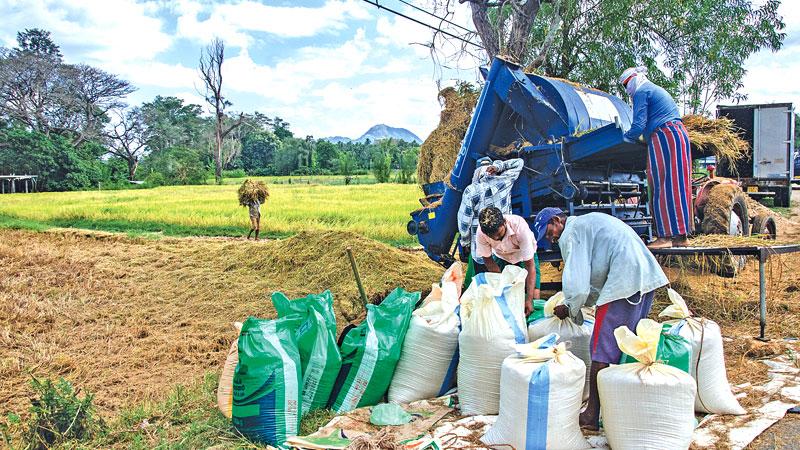
Agriculture is the main livelihood of around 1.8 million people in Sri Lanka. Rice is the staple food of Sri Lankans, and around 2.8 million tonnes of rice are produced annually in the country. Sri Lanka’s legendary harvests once brought fame for the country which earned the name, the ‘Granary of the East’.
 Recently, after visiting the Alikota Ara reservoir near Wellawaya, we were heading back to Wellawaya town, which is a flourishing agricultural region in the country, when I caught a glimpse of farmers harvesting paddy in the scorching sun. What caught my attention was them using machinery for the harvest instead of the age-old method of water-buffaloes and manual labour.
Recently, after visiting the Alikota Ara reservoir near Wellawaya, we were heading back to Wellawaya town, which is a flourishing agricultural region in the country, when I caught a glimpse of farmers harvesting paddy in the scorching sun. What caught my attention was them using machinery for the harvest instead of the age-old method of water-buffaloes and manual labour.
For generations, paddy farmers have employed traditional methods to preserve indigenous paddy seeds. These include, Kaluheenati, Batapolavel, Kuruluthuda, Pachchaperumal, Kuruwee and Suwandel. To the farmers, every stage of paddy cultivation is a divine activity and a ritual. Wellawaya near Buttala, is a treasure-house of indigenous paddy seeds and the farmers have preserved a rare collection of a few varieties. “A few generations ago, our ancestors had cultivated more than 150 varieties of paddy seeds, but most of them have been lost over time,” Ukkubanda, 78, a traditional paddy farmer owning 2.5 hectares of land in a village close to AlikotaAra, tells me. “I fear that the traditional practice may vanish soon as the number of experts in paddy farming are very few now,” he says.
“All the work, from sowing to harvesting, is being done by my family and we do not purchase rice from shops,” says Gunawardena, another farmer. “Now, many farmers in the area are interested in traditional rice cultivation, due to various afflictions suffered by the hybrid varieties recently.”
Modern vs tradition
The rhythm of the island’s paddy cultivation cycles harmonizes with the monsoon rains: the northeast monsoon watered the Maha Kannaya and the southwest monsoon watered the Yala Kannaya.
The farmers sitting in a watch hut or Pela for months on end, stay awake to keep destructive animals at bay. By the end of February, the green fields would gradually turn a golden brown and the machines would appear, crawling amid the paddy clumps like huge beetles, reaping and threshing simultaneously.
However, in the bygone days, harvest time was a time of rejoicing when they used age-old traditions to harvest the fields. And what merry days they were, full of joyous fulfilment! The happiest sounds of the rural scene are the songs sung by the reapers (goyamkavi) as they rhythmically cut the grain, relating tales of their trials and rewards. Reaping in Sri Lanka is still done with the age-old sickle, although it has been now taken over by modern machines.
I have nostalgic memories of the paddy harvesting period in my village, four decades ago, when I was just a little boy. Each year, my three brothers and I would join my father to harvest our paddy field. The harvested grain is then bundled in large rush mats and hauled on the threshing floor. The mats are then expertly stacked in tight beehive mounds. When all the rice has been reaped, a pair of water buffaloes are driven round and round the threshing floor, separating the grain from the chaff. We had wonderful experiences in the paddy fields as village lads.
Despite the invisible boundaries, paddy cultivation was a team effort. My father owns his own plot and during ploughing, sowing and harvesting everyone would get together to help my father. It is the same for the neighbouring farmers.
Perhaps, the most rigorous observance of custom in the cultivation of paddy is on the kamatha – the threshing floor. The important activities of ploughing, seeding, harvesting and threshing are initiated at auspicious times. No chances are taken here, as any mistake would be a harbinger of a poor return. No horseplay or loose talk is tolerated, a special language is even used to confound evil spirits who might eavesdrop, and to preclude the casting of wicked spells on the grain harvest.
Winnowing is also done the old fashioned way, i.e. the threshed grain is winnowed with a kulla, or winnowing basket. The grain then falls down while the chaff (bol wee) blows away in the wind. When it is completed, the grain is measured and stored in wooden lofts. The new grain is hulled and a portion of the new rice cooked with milk and jaggery and, together with some uncooked grain, offered to temples, thus fulfilling the pledge made at the sowing. Delicious rice-meals and sweetmeats (kevum and kokis) also form part of the offering.
Mechanized harvesters
What I have described above is the traditional method of paddy cultivation in Sri Lanka, followed from generation to generation. However, today, traditional farming is under threat. The lack of labour has forced farmers to use mechanized harvesters for cultivation, though the harvest remains labour-dependent. In the past, water-buffaloes were widely used not only for threshing paddy, but also ploughing the fields, whereas today, machinery has put many of these water-buffaloes out to pasture.
Ever since the harvest season began a few weeks ago, a large number of paddy harvesting machines known as ‘boothaya’ and ‘sunami’ have been brought to the Wellawaya region, and stationed at strategic places to cash in on demand.
Since most farmers find the harvesting machines easier and less time consuming, there is a great demand for them. The operators have increased the rent this year, which has risen to Rs. 9,000 an hour for harvesting paddy on dry and wet fields.

